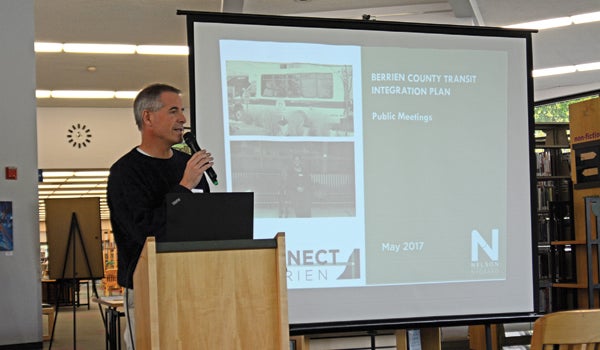Connect Berrien project seeks public feedback on proposal to create one busing system
Published 10:47 am Thursday, May 11, 2017

- Pat Brandstatter addresses residents during a public meeting on the Transit Integration plan Tuesday night at the Niles District Library. (Leader photo/KELSEY HAMMON)
Niles’ Mindy Corak used to be able to rely on the Niles Dial-A-Ride to get to work at the YMCA. But that was 10 years ago.
Diagnosed with the rare connective tissue disorder called Shprintzen as a teenager, Corak refused to let the condition keep her from working, so long as she was healthy enough some days, that was tough enough.
When the bus schedule changed, the limited hours played a role in taking away the hours Corak could work — dropping her hours from 20 to three, she said.
On Tuesday night Corak and her mother, Judy, joined nearly a dozen residents in the Niles District Library to provide feedback during a public meeting for the Connect Berrien project team.
The project, which is sponsored by the Southwest Michigan Planning Commission, is proposing an integration of the transit system’s four current services: Berrien Bus, Twin Cities Area Transit Authority, Niles Dial-A-Ride Transportation, and Buchanan Dial-A-Ride serve residents.
But to get an idea of how such a system could best serve residents, the project leaders are hosting a number of public meetings and gathering feedback online to help inform the team’s working Transit Integration Plan.
Despite having four available transit system, residents who use the buses often face inefficiencies, said Greg Strangeways, a senior associate with the project consultation company Nelson/Nygaard.
Much like Corak, bus riders may often deal with restricted ride schedules. Others in more rural areas have limited access to transit or no access at all, while the multiple systems can also be hard for first time users to follow.
“If people cannot get to jobs then employees are potentially underemployed and are not getting all the help that they could get,” Strangeways said.
Other riders might have trouble getting to doctors appointments, the grocery store or educational opportunities.
With the creation of an integrated system, Strangeways said some of those flaws could be eliminated. With one transit system
operating, customers could potentially have lower, more standardized fares, as well as an increase in ride coverage and an increase in access hours, including evening and weekend rides.
While some things will be fixed, the integrated system does not come without some compromises.
“The new system won’t meet every need, but it can be a lot better than what is there today,” Strangeways said.
Listening to the presentation Tuesday evening was fourth ward city councilman, John DiCostanzo.
DiCostanzo asked if instead of a government system, the city could provide the chance for business entrepreneurs to offer more private services.
“Does more expense get incurred by government support than if we had the abilities to have private companies [operate]?” DiCostanzo asked. “Are there private companies mentioned in your study?”
In response, Pat Brandstatter, Steering Committee member, broke down the cost of the system and said that Niles, Buchanan and Benton Harbor millages help to cover some of the cost for public transit, which accrues less than $300,000 a year on an annual operating budget of approximately $4.3 million. State and federal government covers the other approximate 80 percent of that cost as the system functions now.
With fare prices ranging under $5, an affordable system to residents who otherwise have no form of transportation is a critical need in the community, officials said. Many in the audience that evening discussed ways in which public transit allows them to get to doctors appointments and jobs, which allows them to be tax paying citizens themselves.
For people who have cars, it can be difficult to understand these challenges, Brandstatter said. He encouraged those at the meeting to advocate for those who depend on public transit.
“We have to get the individuals who do not think twice about it, because they have their own car and can go where they want when they need to,” Brandstatter said. “They need to be aware that there is an issue with public transportation in our county and there are people who need it.”
Audience members also brought up how some available private companies are not cost effective. One service in the area that offers rides to doctors appointments costs $90 one way.
In the coming months, Brandstatter said project leaders hope to continue to gauge from the public how a new system could better serve them.
“If we do not do something then we are going to end up with nothing,” Brandstatter said.
As she pondered the changes, Corak and her mother said they thought the proposed system could be better.
“I think monetarily it could be good, because there would be more riders,” Judy said. “I cannot see any downside of this. There is an opportunity.”
Those interested in offering up their feedback can do so by visiting connectberrien.org. Participants can also use an interactive tool to build their own public transit system on the website.
Project leaders are looking to implement changes as early as this year or the beginning of 2018.
The Connect Berrien project is funded through a grant from the Federal Transit Administration. Matching funds are also provided by the Lakeland Foundation, the Berrien County Manufacturers Association and the County of Berrien.
Future meetings on the topic are expected to take place in the fall and dates will be announced at a later time.






